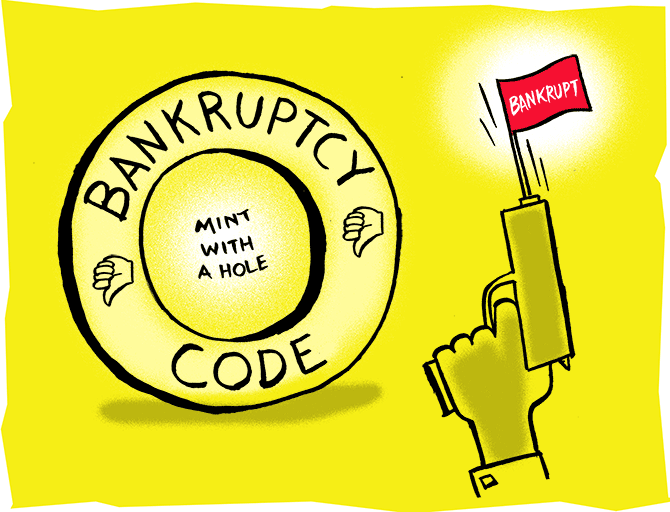The cut-off date the RBI chose was March 1, 2018. This meant that by the end of August if these accounts were not resolved, then they would have to proceed through insolvency.
Illustration: Dominic Xavier/Rediff.com

Till recently, the Insolvency and Bankruptcy Code (IBC) was projected by the government as a silver bullet for resolving the bad loans that have been plaguing the banking system.
But that seems to have changed, with Finance Minister Piyush Goyal announcing an alternative mechanism for resolving bad loans.
Will this new plan - Project Sashakt - actually take off in time to prevent these toxic loans from moving to resolution under the IBC?
In principle, the IBC process provides a transparent system of resolving bad loans.
The code did away with any role for government in the process. It instead introduced a time-bound transparent price-discovery process for bad loans between prospective buyers and creditors under a judicial cover.
This provided bankers the assurance that their tough decisions on the extent of haircuts would not face scrutiny later.
To hasten the pace at which bankers move bad loans through the IBC process, on February 12, the Reserve Bank of India (RBI) took yet another step, ordering banks to start the resolution process for any large account which was overdue by even a single day.
The RBI gave them a maximum of 180 days to come up with a resolution.
In case that did not happen, the central bank told banks to immediately push the unresolved cases through insolvency proceedings under the IBC.
The cut-off date the RBI chose was March 1, 2018. This meant that by the end of August if these accounts were not resolved, then they would have to proceed through insolvency.
The push from the RBI apparently did not sit well with the government.
The power ministry requested the RBI to make an exception for the ailing power sector, which, according to analysts, accounts for bulk of the bad loans in the pipeline that are hurtling towards the IBC process.
The government has not named the companies that could potentially gain if the RBI relaxed its norms.
But an investor presentation by Power Finance Corporation (PFC) shows that more than 12.46 gigawatt of power plants, beyond those already under insolvency proceedings, also face a crisis.
As of March 31, these were yet to put through the IBC process. PFC’s exposure alone to these companies stood at Rs 22,300 crore.
The total outstanding debt of these companies, to all their lenders including banks, is likely to be of a much higher magnitude.
Then there could be other power projects which PFC does not have exposure to but have also soured.
The finance minister’s presentation on July 2 said that the total volume of bad loans Project Sashakt could address was roughly Rs 3 trillion.
The government’s parleys with the RBI failed, with the latter refusing to make an exception for the power sector.
Subsequently, the finance ministry proposed Project Sashakt. The project, if it takes off, would operate in a contrasting manner to the IBC.
IBC versus Sashakt
The proposed plan under Sashakt differs substantially from the IBC process.
First, under the IBC, promoters lose control over their companies as soon as the company is accepted by the National Company Law Tribunal for resolution.
The resolution professionals take over management control till a new buyer is found.
But under Project Sashakt, promoters are likely to continue to be a part of the company and could well retain a management hold over the company.
The finance minister’s presentation on Sashakt was silent on this issue.
But, later Sunil Mehta, chairman of Punjab National Bank and head of the committee, told media that the promoters’ stake would be brought down to 24 per cent once the loans of the companies are taken over by a newly set up asset management company (AMC).
But according to senior bankers and experts that Business Standard spoke to, the conversion of bad debt to equity would probably be decided on a case-to-case basis depending on the loan agreements, the credit outstanding, and the willingness of lenders.
“Through Sashakt we are only trying to resolve the debt side of the balance sheet. The management of the company could stay where it is,” said a senior lawyer at a top law firm.
A senior official at one of the largest banks in the country concurred.
“The stake of the promoter would be negotiated on a case-to-case basis,” he said.
Most bankers and experts that Business Standard spoke to preferred to speak off the record. The finance ministry did not respond to detailed questions from Business Standard.
Second, for bankers as well, Project Sashakt provides an easier route out as compared to the IBC.
Under the IBC, banks are able to take bad loans off their books only once the resolution process is complete - either when a buyer has been found or the company is liquidated.
This, as current trends suggest, could take more than the mandated 270-day period.
However, under Sashakt, banks would be able to push the bad loans off their balance sheets to the proposed AMC even as the loan recovery process takes its own course.
Third, assessments by different analysts show that the recovery rates for the power sector under the IBC are likely to hover around 25 per cent in cases where there are willing buyers.
Several bankers and analysts raised concerns, that in the prevailing economic scenario, many power companies may simply face liquidation.
“Under the IBC, bankers may have to book massive losses against their power sector loans. But under the AMC approach, there will be some breathing space,” said a lawyer working in an asset reconstruction company (ARC).
For the government too, liquidation could pose its own set of challenges with existing power capacity being destroyed even as the economy is likely to see an uptick in the medium term.
The RBI deadline
Even as details of Project Sashakt are yet to emerge, it could turn out to be a rescue job undertaken too late in the day - all the project’s formalities have to be completed by the end of August when the RBI’s deadline to take fresh set of bad loans to IBC kicks in.
Regulatory hurdles to set up or re-engineer and existing AMC/ARC would have to be overcome quickly.
The money to capitalise these institutions would have to be found.
Further, banks will also have to sign inter-creditor agreements for all impending bad loans.
Analysts warn the time line to achieve this could breach the RBI’s August deadline. In which case the government have to revert to the RBI and ask for postponing the deadline - an idea the RBI earlier refused to entertain.
“The borrowers need to be referred under the IBC by September 1, 2018. So the timelines for creation, funding of the AMC, and transfer of the stressed loans to AMC appears to be very tight.
"Hence possibly, the stakeholders will need to approach the RBI for extension in the above timeline by few months,” said Anil Gupta, head-financial sector ratings at Icra.











